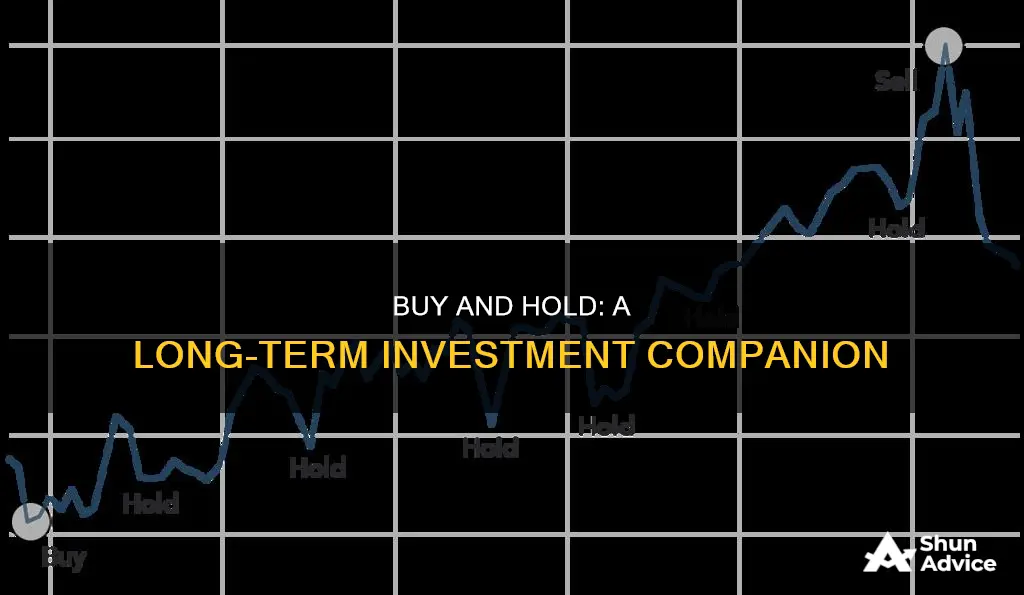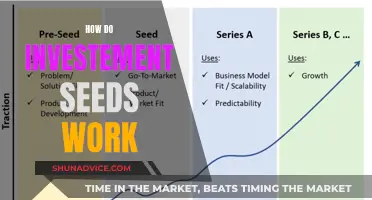
A buy-and-hold investment strategy is a passive approach where investors buy stocks or other securities and hold them for a long time, regardless of market fluctuations. The goal is to realise price appreciation over time, despite short-term peaks and valleys. This strategy is based on the belief that the chosen assets will appreciate in value over time, leading to substantial returns. It is often associated with stock market investments but can also be applied to other asset classes such as bonds, real estate, and certain commodities.
| Characteristics | Values |
|---|---|
| Type of Investment Strategy | Passive |
| Investment Types | Stocks, ETFs, Mutual Funds, Index Funds, Bonds, Real Estate, Commodities |
| Investor Behaviour | Not affected by short-term market fluctuations, recency bias, emotions, risk aversion |
| Holding Period | Long-term, decades |
| Selling Behaviour | Doesn't sell after a decline in value, doesn't engage in market timing |
| Investment Selection | Companies with strong business fundamentals, solid management team, good growth potential |
| Investment Objective | Capital appreciation, long-term growth |
| Risk | Inflexible, opportunity cost, market risk, underperforming investments |
| Advantages | Simplicity, tax benefits, reduced transaction costs, compound interest |
| Disadvantages | Poor risk management, no profits from market volatility |
What You'll Learn

The benefits of buy and hold investing
The benefits of buy-and-hold investing
The buy-and-hold investment strategy is a passive, long-term strategy where investors build a stable portfolio and hold their investments for an extended period, ignoring short-term market fluctuations. This strategy is simple to execute and has been proven to return exponential gains on invested capital. Here are some of the benefits of buy-and-hold investing:
Simplicity and Minimal Risk of Investor Error
The buy-and-hold strategy is simple: buy a financial security and don't sell it. This simplicity means there is a very low risk that the strategy will fail due to tactical errors.
Tax Efficiency
Buy-and-hold investors can benefit from tax deferral and more favourable long-term tax rates. Not selling stocks means investors don't owe capital gains taxes on stock sales. When they do sell, they can do so in ways that minimise their tax liabilities.
Compound Interest Effect
Buy-and-hold investors can take advantage of compound interest. As investments grow, the returns generated can be reinvested, leading to even more growth. This is particularly effective for interest-bearing investments like bonds or dividend-paying stocks.
Reduced Transaction Costs
Active trading incurs various costs, including brokerage fees, commissions, and taxes, which can eat into returns. By reducing the frequency of transactions, the buy-and-hold strategy minimises these costs, allowing more of the investor's capital to remain invested and grow.
Democratisation of Wealth Creation
This strategy is accessible to a broad range of investors, including those with limited time or expertise to engage in frequent trading. It allows individuals to participate in the growth of economies and industries without constantly monitoring and reacting to market movements.
The Art of Investing: Exploring Alternatives to the Picasso Path
You may want to see also

The drawbacks of buy and hold investing
The buy-and-hold investment strategy has several potential drawbacks that investors should carefully consider before deciding if it is right for them. Here are some of the key disadvantages:
Inflexibility and Opportunity Cost
The buy-and-hold strategy is relatively inflexible, as investors commit their money to the market for years or even decades. This lack of liquidity means that investors may miss out on short-term opportunities to make profits. The strategy may not be suitable for those who need access to their money in the near future or who are uncomfortable with the risks associated with the stock market.
Market Risk and Losses
Buy-and-hold investors are not immune to market risk and the potential for losses. Markets can experience significant downturns, eroding the value of an investor's portfolio. There is also a chance that selected investments may not perform as expected over the long term, with companies failing, industries declining, or economic shifts impacting performance.
Time Commitment
Buy-and-hold investing requires a significant time commitment. Even after holding an asset for many years, there is no guarantee of a large reward. Some investments may be stagnant or underperform, and it can take time to see growth.
Discipline and Emotional Challenges
This strategy demands discipline from investors, who must resist the temptation to sell off investments during market downturns. It can be emotionally challenging to maintain confidence in investment choices during turbulent periods or when witnessing others profit from short-term trading.
Volatility and Fluctuations
While the market generally trends upward over the long term, short-term fluctuations can be significant and unpredictable. A buy-and-hold investor must understand and accept these fluctuations, maintaining a long-term perspective to navigate through volatile periods.
The Debt Dilemma: Pay Off in Full or Invest?
You may want to see also

How to build a buy and hold portfolio
A buy-and-hold strategy is a passive investment strategy where an investor buys stocks or other securities and holds them for a long time, regardless of market fluctuations. This strategy is based on the belief that well-chosen investments will appreciate over time, resulting in healthy long-term returns.
Select the Right Assets:
The key is to choose investments that align with your personal financial objectives and risk tolerance. Analyse the company's financial health, market position, growth potential, and management quality for stocks. For bonds, consider factors like credit quality, duration, and interest rates. Real estate investments require evaluating location, market trends, and property potential.
Diversify Your Portfolio:
Diversification is critical to mitigating risk. Spread your investments across different asset classes, sectors, and geographies. Include a mix of stocks, bonds, and real estate in your portfolio. Exchange-traded funds (ETFs) and mutual funds are excellent tools for diversification, providing exposure to various investments.
Understand Your Risk Tolerance:
Determine how much risk you are willing to take to achieve your financial goals. The longer your time horizon, the more aggressive you can be, as you have more time to recover from potential losses. However, if you are closer to retirement, for example, taking on too much risk could lead to significant losses without a chance to recoup.
Set Clear Investment Goals:
Define your short-term and long-term financial goals. Short-term goals are those where you need the money within a year, medium-term goals take one to five years, and long-term goals are those that will take more than five years to achieve. This will help you structure your portfolio accordingly.
Monitor, Rebalance, and Adjust:
While a buy-and-hold strategy involves holding investments for the long term, it's important to regularly monitor and adjust your portfolio. Check in on your portfolio at least twice a year to ensure it remains aligned with your investment goals. You may need to rebalance your holdings due to market volatility or changes in your financial situation, investment goals, or risk tolerance.
Exercise Patience and Discipline:
Buy-and-hold investing requires patience and discipline to stick to your investment plan, even during market volatility. Emotional reactions to short-term fluctuations are common pitfalls. Maintain a long-term perspective and focus on your financial objectives.
Consider Dollar-Cost Averaging:
Dollar-cost averaging (DCA) is a strategy well-suited for long-term investing. It involves investing a fixed amount regularly, regardless of market conditions. This approach can help remove emotional decision-making and reduce the impact of purchasing assets at high prices.
Remember, building a buy-and-hold portfolio requires careful consideration of your financial goals, risk tolerance, and investment horizon. It demands a long-term commitment and the ability to withstand short-term market fluctuations.
Home Sweet Home: Weighing the Benefits of Selling Investments to Buy a House
You may want to see also

How long should you buy and hold?
The length of time an investor should buy and hold depends on several factors. Firstly, it depends on the investor's risk tolerance and time horizon. Those with a long-term time horizon are more likely to be able to ride out market corrections or downturns, whereas those who need the money in the short term may have a different strategy. Age also plays a role here: a 25-year-old investor may hold their investments for several years, while a retiree or someone close to retirement will likely have a shorter time horizon.
Secondly, the performance of the company in question should be considered. If a stock rises 20-25% past a proper buy point, profits should be taken. If a stock jumps more than 20% from a breakout point in three weeks or less, it should be held for at least eight weeks. After that, the stock's chart should be studied to see if it is holding up well. If so, and the market is rising, the uptrend will likely continue, and the investor should hold.
Thirdly, the market cycle should be considered. A bull market tends to last two to four years, with big money made in the first year or two. In a general bull market, winners may be held for years.
Finally, the investor's confidence in the company should be considered. If an investor knows and understands a company and its products well, they will have the confidence to sit tight through corrections.
Warren Buffett, a proponent of the buy-and-hold strategy, once said: "If you aren't thinking about owning a stock for 10 years, don't even think about owning it for 10 minutes."
Inward Investment: A Country's Economic Lifeline
You may want to see also

How does buy and hold compare to position trading?
Buy and hold, also called position trading, is an investment strategy where an investor buys financial assets or non-financial assets such as real estate, and holds them for a long time, with the goal of price appreciation, despite market volatility. This strategy is passive and is based on the confidence that the value of the investments will increase in the future.
Position trading, on the other hand, is a more active and short-term strategy. It involves taking a position in a particular stock or market and holding it for a relatively longer period, which could range from a few weeks to several months. Position traders aim to profit from significant price movements and trends. They use technical analysis, charts, and indicators to identify entry and exit points.
Buy-and-hold investors, however, are not concerned with short-term price movements and technical indicators. They focus on the long-term potential of their investments and are willing to hold through bull and bear markets. Buy-and-hold investors tend to prioritise owning shares of companies with strong business fundamentals and are less concerned with short-term stock price changes.
While position trading allows investors to take advantage of short-term market trends and potentially profit from them, buy-and-hold investors aim for long-term capital appreciation and are less affected by market volatility. The buy-and-hold strategy is also simpler to execute and has tax benefits, as investors can defer capital gains taxes on long-term investments.
In summary, position trading and buy-and-hold are both investment strategies, but they differ in terms of time horizon, level of activity, and focus. Position trading is more short-term and active, while buy-and-hold is a long-term, passive strategy.
Strategic Retirement: Investing $700,000 for a Secure Future
You may want to see also
Frequently asked questions
A buy-and-hold investment strategy is a passive strategy where investors buy stocks or other securities and hold them for a long period, sometimes decades, regardless of fluctuations in the market.
A buy-and-hold investment strategy is relatively simple and can be a good option for beginners. It can also save investors money by reducing fees incurred from buying and selling stocks and other securities. It also helps investors avoid making decisions based on emotions like fear or greed.
A buy-and-hold investment strategy is relatively inflexible as investors tie up their money in the market and don't touch it for years. There may be an opportunity cost involved as money that's tied up in the market can't be used for anything else.
Patience and discipline are important for long-term investing. It's also crucial to exercise dollar-cost averaging, which involves investing a fixed amount of money regularly, regardless of market conditions.







